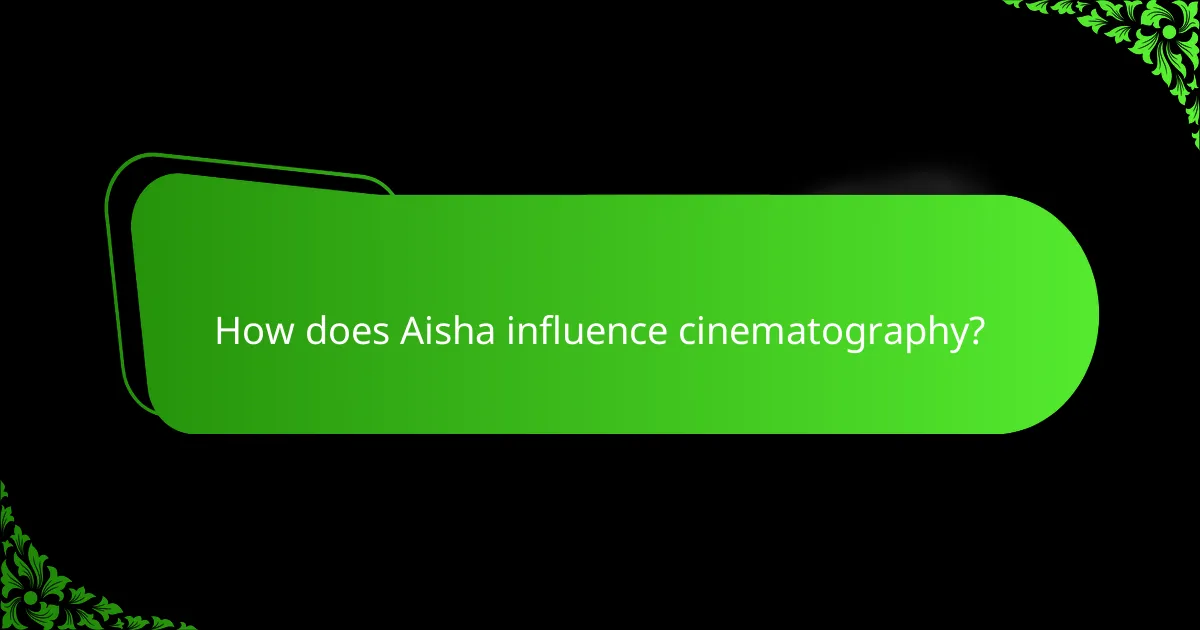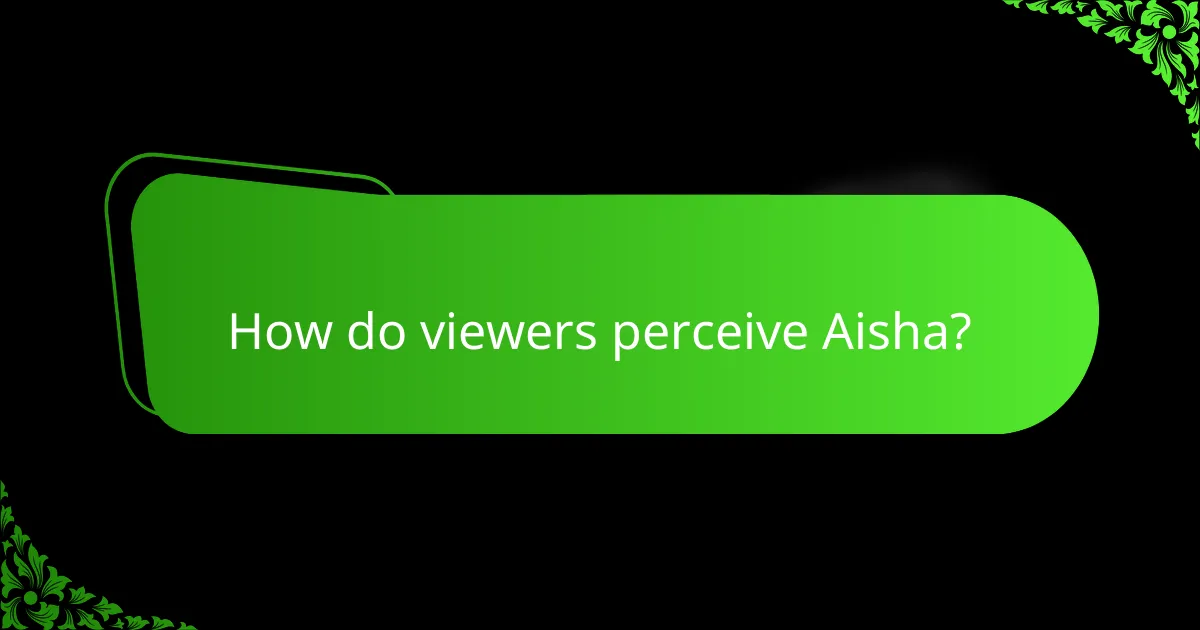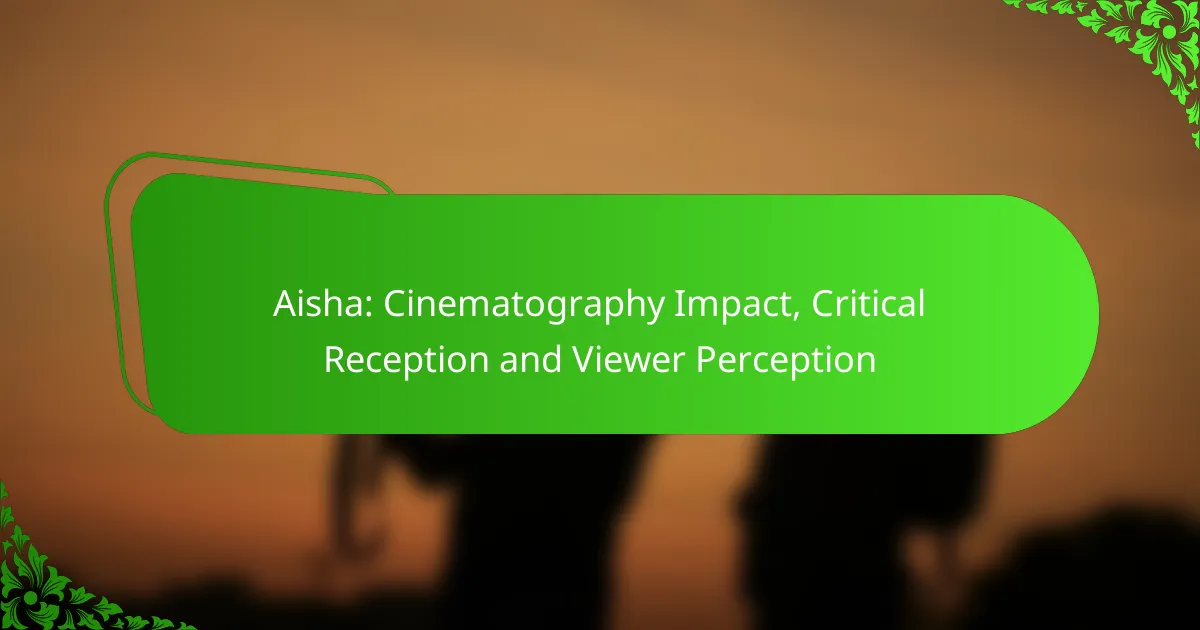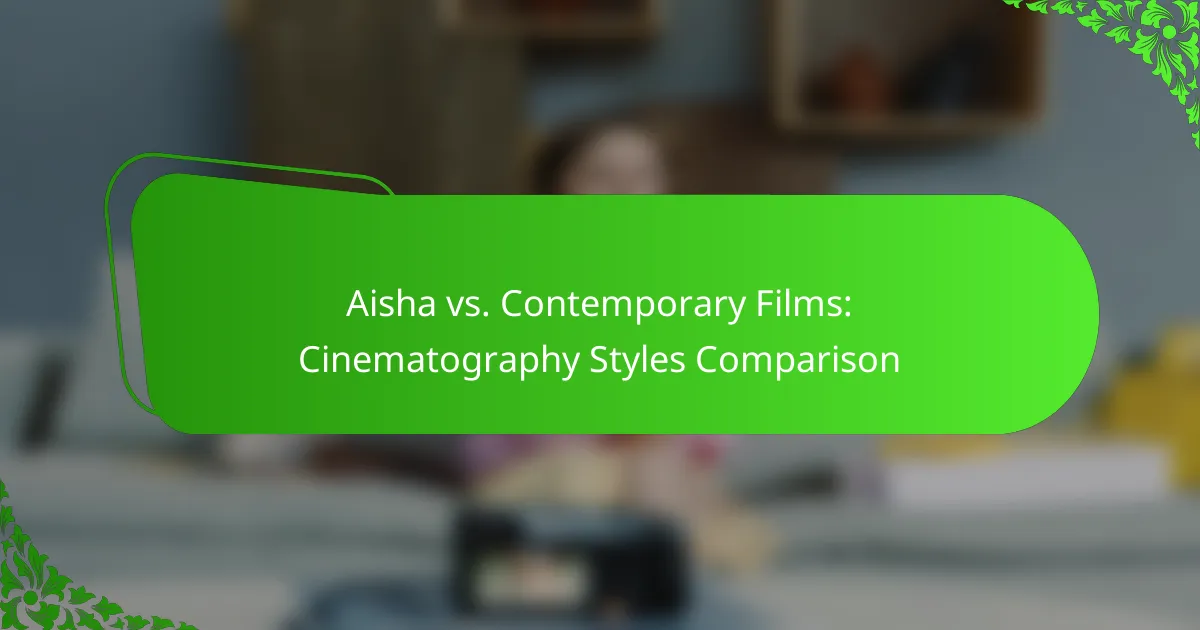Aisha has made a notable impact on cinematography by introducing innovative techniques and visual narratives that elevate storytelling. The film has received positive critical acclaim for its cinematography and storytelling, resonating with audiences while tackling complex themes of identity and culture. Viewers appreciate Aisha as a thought-provoking experience, where striking visuals significantly enhance their emotional connection to the narrative.

How does Aisha influence cinematography?
Aisha significantly impacts cinematography by introducing fresh techniques and visual narratives that enhance storytelling. Its innovative approach has set new benchmarks for filmmakers, encouraging them to explore creative possibilities in visual representation.
Innovative camera techniques
Aisha employs groundbreaking camera techniques that challenge traditional filming methods. For instance, the use of handheld shots creates an intimate connection between the audience and characters, making scenes feel more personal. Additionally, the incorporation of drone footage allows for dynamic aerial perspectives, which can dramatically enhance the visual scope of a scene.
Filmmakers can learn from Aisha’s approach by experimenting with movement and angles. Using a mix of static and dynamic shots can keep viewers engaged and provide a fresh viewing experience.
Visual storytelling advancements
The film advances visual storytelling by integrating symbolic imagery and metaphoric visuals that resonate with the narrative. Aisha’s scenes often juxtapose contrasting visuals to highlight emotional conflicts, which deepens viewer engagement. This technique encourages filmmakers to think beyond dialogue and utilize imagery to convey complex themes.
To enhance visual storytelling, filmmakers should consider how each shot contributes to the overall narrative. Creating a storyboard that emphasizes key visual elements can help maintain coherence and impact throughout the film.
Use of lighting and color
Aisha’s strategic use of lighting and color plays a crucial role in setting the mood and tone of various scenes. The film often employs warm tones to evoke nostalgia and cool tones to create tension, guiding audience emotions effectively. This thoughtful application of color theory can significantly influence how viewers perceive the story.
Filmmakers should experiment with different lighting setups and color palettes to evoke specific feelings. A practical tip is to use color grading in post-production to enhance the emotional undertones of scenes, ensuring that the visual style aligns with the narrative’s intent.

What is the critical reception of Aisha?
The critical reception of Aisha has been largely positive, with many reviewers praising its cinematography, storytelling, and performances. Critics have highlighted the film’s ability to resonate with audiences while addressing complex themes related to identity and culture.
Positive reviews from film critics
Film critics have generally lauded Aisha for its visual appeal and strong narrative structure. Many reviews emphasize the film’s stunning cinematography, which enhances the emotional depth of the story. Critics often note the performances of the lead actors as a significant strength, contributing to the film’s overall impact.
For instance, several prominent publications awarded Aisha high ratings, often citing its unique approach to storytelling and character development. This favorable reception has helped the film gain traction among diverse audiences.
Awards and nominations
Aisha has received multiple awards and nominations, reflecting its critical acclaim and popularity. It has been nominated for several prestigious film awards, including those recognizing excellence in cinematography and direction. Winning awards in categories such as Best Film and Best Actress has further solidified its status in the film industry.
Notably, Aisha’s success at international film festivals has also contributed to its recognition, showcasing the film’s ability to connect with global audiences. This recognition often translates into increased viewership and interest in the film.
Impact on film festivals
Aisha has made a significant impact on various film festivals, where it has been featured prominently. Its selection at major festivals has not only elevated the film’s profile but also sparked discussions about its themes and artistic choices. The film’s presence at these events has encouraged dialogue among filmmakers and audiences alike.
Moreover, Aisha’s success at festivals has inspired other filmmakers to explore similar themes, potentially influencing future cinematic works. The film’s reception at these festivals highlights its role in shaping contemporary narratives within the industry.

How do viewers perceive Aisha?
Viewers perceive Aisha as a thought-provoking film that blends rich storytelling with striking visuals. The cinematography plays a significant role in shaping their overall experience and emotional connection to the narrative.
Audience ratings and feedback
Audience ratings for Aisha generally reflect a positive reception, with many viewers appreciating its artistic approach and character development. On platforms like IMDb and Rotten Tomatoes, scores often range from the mid-seventies to the low eighties out of a hundred, indicating a favorable consensus among critics and audiences alike.
Feedback highlights the film’s cinematography as a standout feature, with comments frequently noting its ability to enhance the storytelling. Viewers often express admiration for the visual aesthetics, which contribute to a deeper engagement with the plot.
Viewer emotional responses
Emotional responses to Aisha vary, but many viewers report feelings of empathy and introspection. The film’s cinematography effectively captures the nuances of the characters’ journeys, allowing audiences to connect on a personal level.
Specific scenes evoke strong reactions, with viewers mentioning moments of joy, sadness, and contemplation. The visual storytelling often amplifies these emotions, making the experience more impactful and memorable.
Social media discussions
Social media platforms are buzzing with discussions about Aisha, where viewers share their interpretations and favorite scenes. Hashtags related to the film often trend, reflecting a vibrant community engaged in analyzing its themes and cinematography.
Many users post reviews and reactions on platforms like Twitter and Instagram, highlighting the film’s visual elements and emotional depth. This online dialogue fosters a sense of connection among fans, as they exchange insights and recommendations for similar films.

What are the cinematographic techniques used in Aisha?
Aisha employs a variety of cinematographic techniques that enhance its storytelling and visual appeal. Key methods include innovative camera angles, dynamic editing styles, and immersive sound design, all contributing to the film’s overall impact.
Camera angles and movements
The film utilizes a range of camera angles and movements to convey emotions and perspectives effectively. High-angle shots often depict vulnerability, while low-angle shots can empower characters, influencing viewer perception. Additionally, smooth tracking shots create a sense of fluidity, drawing the audience deeper into the narrative.
For instance, Aisha frequently employs close-ups during pivotal moments to capture nuanced facial expressions, allowing viewers to connect with the characters’ inner thoughts. This technique enhances emotional engagement and emphasizes key plot points.
Editing styles
Aisha showcases diverse editing styles that contribute to its pacing and narrative structure. Quick cuts are used during intense scenes to heighten tension, while longer takes allow for character development and reflection. This balance keeps viewers engaged and invested in the storyline.
Moreover, the film incorporates cross-cutting to juxtapose different storylines or perspectives, enriching the narrative complexity. This technique helps to build suspense and maintain viewer interest throughout the film.
Sound design integration
Sound design in Aisha plays a crucial role in enhancing the overall cinematic experience. The integration of diegetic and non-diegetic sounds creates an immersive atmosphere, allowing viewers to feel the environment and emotions of the characters. For example, ambient sounds can evoke a sense of place, while a powerful score underscores dramatic moments.
Effective use of sound cues also aids in storytelling, signaling shifts in mood or tension. This thoughtful integration ensures that the sound complements the visual elements, creating a cohesive and engaging experience for the audience.

What themes are explored in Aisha?
Aisha explores themes of identity, culture, and social issues through its characters and narrative. The film delves into personal growth and societal challenges, offering a nuanced portrayal of contemporary life.
Identity and culture
The theme of identity in Aisha is intricately tied to cultural heritage and personal discovery. Characters navigate their backgrounds while grappling with societal expectations, which often leads to conflicts between tradition and modernity.
For example, the protagonist’s journey reflects the struggle to balance familial obligations with individual aspirations. This duality resonates with viewers who may face similar cultural dilemmas in their own lives.
Social issues representation
Aisha addresses various social issues, including gender roles, economic disparity, and mental health. The film highlights the challenges faced by women in a patriarchal society, showcasing their resilience and determination to overcome obstacles.
By portraying real-life struggles, Aisha fosters a deeper understanding of these issues among its audience, encouraging discussions about change and empowerment. The characters’ experiences serve as a mirror to societal norms that need reevaluation.
Character development
Character development in Aisha is central to its narrative, with each character undergoing significant transformations. The film effectively illustrates how personal experiences shape identities and influence relationships.
For instance, as the protagonist confronts her fears and insecurities, she evolves into a more assertive individual. This growth not only enhances her character arc but also inspires viewers to reflect on their own journeys of self-discovery.

How does Aisha compare to other films in its genre?
Aisha stands out in its genre by blending romantic comedy with social commentary, a combination that is less common among similar films. While many films focus solely on romance or humor, Aisha incorporates themes of class and gender, providing a richer narrative experience.
Cinematography Impact
The cinematography in Aisha plays a crucial role in establishing its tone and enhancing the storytelling. The use of vibrant colors and stylish framing reflects the protagonist’s affluent lifestyle, while also contrasting with the more subdued environments of other characters. This visual storytelling helps to underscore the film’s themes of privilege and social disparity.
Critical Reception
Aisha received mixed to positive reviews from critics, who praised its stylish presentation and performances, particularly that of the lead actress. However, some critics pointed out that the film’s plot could feel predictable and formulaic compared to other works in the romantic comedy genre. Overall, it has been recognized for its unique take on familiar tropes.
Viewer Perception
Viewer perception of Aisha tends to vary, with many appreciating its humor and visual appeal, while others critique its lack of depth in character development. Audiences often enjoy the film’s light-hearted moments but may feel that the social issues presented are not fully explored. This duality in perception highlights the film’s appeal to a broad audience while also revealing its limitations.










